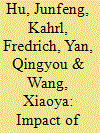|
|
|
Sort Order |
|
|
|
Items / Page
|
|
|
|
|
|
|
| Srl | Item |
| 1 |
ID:
105823


|
|
|
|
|
| Publication |
2011.
|
| Summary/Abstract |
We examine the challenges to China's transition to a low carbon electricity system, in which renewable energy would play a significant role. China's electricity system currently lacks the flexibility in planning, operations, and pricing to respond to conflicting pressures from demand growth, rising costs, and environmental mandates in a way that simultaneously maintains reliability, decarbonizes the system, and keeps prices within acceptable bounds. Greater flexibility crucially requires the ability to more systematically and transparently manage and allocate costs. This will require re-orientating sector institutions still rooted in central planning, and strengthening independent regulation. Some of the necessary changes require fundamental political and legal reforms beyond the scope of energy policy. However, the system's flexibility can still be increased through the development of traditional planning and regulatory tools and approaches, such as an avoided cost basis for energy efficiency investments, more integrated planning to improve the coordination of generation, transmission, and demand-side investments, and a transparent ratemaking process. The judicious application of OECD electricity sector experience and skills can support these developments.
|
|
|
|
|
|
|
|
|
|
|
|
|
|
|
|
| 2 |
ID:
113453


|
|
|
|
|
| Publication |
2012.
|
| Summary/Abstract |
This article investigates the impact of China's differential electricity pricing policy on power sector CO2 emissions using the logarithmic mean divisia index method. The differential pricing policy, intended to reduce energy intensity in manufacturing, is being implemented in eight electricity-intensive industries. The study finds that, during 2004-2009, the policy accounted for a drop of roughly 115 TWh in electricity use, which amounted to a reduction of 82 million tons of CO2 emissions. The policy has been most effective in reducing electricity use in the nonferrous metal smelting and rolling industry, and least effective in the ferrous metal smelting and rolling industry. Because the differential pricing policy has had significantly different effects across industries, improving the policy's design and implementation going forward will require a more detailed understanding and analysis of how it can be better tailored to individual industries.
|
|
|
|
|
|
|
|
|
|
|
|
|
|
|
|
| 3 |
ID:
117335


|
|
|
|
|
| Publication |
2013.
|
| Summary/Abstract |
The transition to a cleaner and more cost-efficient electricity system in China is political-economic as well as technological. An example is the reform of China's method of dispatching power plants, which potentially affects the economic relationships between consumers and producers, between grid and generating companies, and between central and provincial governments. Historically, coal-fired power plants in China all received roughly the same number of operating hours, regardless of efficiency or cost. In 2007, Chinese government agencies began to pilot "energy efficient dispatch," which requires that generators be dispatched on the basis of thermal efficiency. Using a case study of Guangxi Zhuang Autonomous Region in southern China, we evaluated potential energy and cost savings from a change to energy efficient dispatch. We found that the savings are at best relatively small, because large, efficient generators already account for a significant share of total generation. Moreover, as an administrative policy that does not change economic incentives, energy efficient dispatch exacerbates imbalances and center-provincial tensions in the current system. We argue that incentive-based dispatch reform is likely to produce better outcomes, and that the keys to this reform are empowering an independent regulator with pricing authority and establishing a formal, transparent ratemaking process.
|
|
|
|
|
|
|
|
|
|
|
|
|
|
|
|
| 4 |
ID:
181773


|
|
|
|
|
| Summary/Abstract |
Since the 2007–2009 financial crisis, U.S. electricity sales have remained essentially flat despite economic recovery, with all but five states registering declines in electricity sales growth between the two decades on either side of the financial crisis. This paper examines the factors that contributed to the decline in annual average electricity sales growth from 1997 to 2007 to 2009–2019 across states. It finds that, at a national level, most (∼60%) of the decline in sales growth was in the commercial sector. The factors driving declines in sales growth across states were heterogeneous. The only statistically significant factor (p < 0.05) was a decline in the growth of the number of commercial customers, which occurred in all but two states. Over the last decade, customer count growth slowed across both commercial and residential classes in almost all states. These changes may reflect structural economic and demographic changes and require further analysis. The results highlight the structural economic factors — as opposed to energy efficiency and other technological factors — that are currently shaping electricity demand in the United States. They underscore the importance, for electric utilities, system operators, and their regulators, of developing more effective strategies to manage load forecast uncertainty.
|
|
|
|
|
|
|
|
|
|
|
|
|
|
|
|
|
|
|
|
|